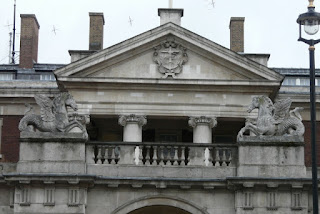This is an excerpt from the tour Oxford’s Noble and Great Ones - Part
1 which explores around the
southern part of Oxford. The full tour is found
on www.obelisktours.co.uk
Facing the Botanic Gardens is Magdalen College. The first surprising thing about this college is its spelling. You would expect it to be pronounced like Mary Magdalene when in fact it is ‘Maudlin’. Some claim it is just how it was pronounced centuries ago without the ‘g’, but it also seems we have a play on words here. Mary Magdalene anointed the feet of the Saviour, was present at the Crucifixion and at the tomb and most artistic depictions show her looking sorrowful. Maudlin is a word meaning tearful or sentimental. So we get both an historical figure and an emotion in one word - two for the price of one.
William of Waynflete
(1398-1486), Bishop of Winchester, founded “Seint Marie Maudeleyn Halle” in
1448, but it was not until 1456 that he gained the current location and
Magdalen College came to life in 1458.
Magdalen was blessed with benefactors from the start. One of the earliest gifts came from the
estate of John Fastolf (1380-1459), who may be the inspiration for Falstaff
featured in William Shakespeare’s plays.
The College has 100 acres of grounds which includes a herd
of Fallow Deer.
The Tower greets everyone entering Oxford. It was built by William Orchard (1468-1504)
who also designed the quad behind the tower, the vaults of the Divinity School,
and the chancel of Christ Church Cathedral.
It has been a tradition for the college choir to sing from the top of
Magdalen tower at 6 am on May Day (May
1). The event draws large crowds
and is followed by dancing and music in the streets below.
More details about the people, places and events associated
with these sites can be found on the tour Oxford’s Noble and Great Ones - Part 1 available
on www.obelisktours.co.uk





















